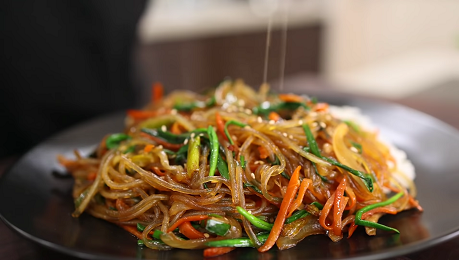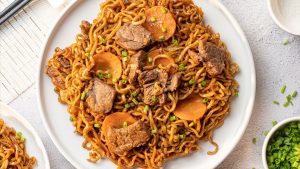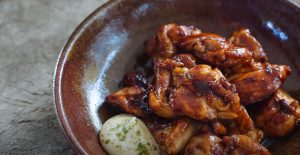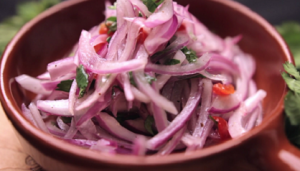This quick Korean noodle stir-fry, known as japchae, is a delightful mix of flavors and textures. Featuring soft sweet potato noodles, tender steak, and a colorful array of vegetables, it's a dish that's both comforting and nutritious.

Some ingredients in this recipe might not be common in every household. Dangmyeon are Korean sweet potato noodles with a chewy texture that you might need to find in an Asian supermarket. Additionally, Shiitake mushrooms and sesame oil could be less common but are essential for the authentic flavor of japchae.
Ingredients For Japchae Quick Korean Noodle Stir-Fry
Dangmyeon: Korean sweet potato noodles known for their chewy texture.
Olive oil: Used for sautéing the vegetables and steak.
White onion: Adds sweetness and depth to the stir-fry.
Shiitake mushrooms: Earthy mushrooms that enhance the umami flavor.
Red bell pepper: Adds a sweet and colorful element to the dish.
Carrot: Provides a slight crunch and sweetness.
Garlic: Infuses the stir-fry with aromatic flavors.
Baby spinach: Adds a fresh and vibrant touch to the dish.
Toasted sesame seeds: Used for garnishing, adding a nutty flavor and texture.
Green onions: Thinly sliced and used as a garnish for a fresh, sharp taste.
Soy sauce: The base of the sauce, providing a salty umami flavor.
Maple syrup: Adds a subtle sweetness to the sauce.
Toasted sesame oil: Adds a rich, toasty flavor to the dish.
Steak: Provides protein and a savory element.
Fine sea salt: Enhances the overall flavor.
Freshly-cracked black pepper: Adds a touch of heat and complexity.
One reader, Brena Lemaster says:





This japchae recipe is fantastic! The flavors are perfectly balanced, and the dish is both delicious and easy to make. The steak adds a great touch, and the veggies are vibrant and fresh. Definitely a new favorite in our household!
Techniques Required for Making Japchae
How to cook sweet potato noodles: Follow package directions to cook the noodles al dente in boiling water, ensuring they are not overcooked to avoid mushiness. How to marinate steak: Combine steak with soy sauce and black pepper, then let it marinate for 5 to 30 minutes. How to sauté: Heat oil in a pan over high heat, add ingredients, and cook while stirring occasionally until desired doneness is achieved. How to wilt spinach: Add spinach to the pan and cook for about 2 minutes, using tongs to toss frequently until the spinach has wilted. How to combine ingredients: Mix cooked noodles, steak, sauce, and vegetables in the pan, tossing to combine evenly.
How To Make Japchae (Quick Korean Noodle Stir-Fry)
Japchae is a Korean noodle dish with sweet potato starch noodles. Customize it with your desired veggies & proteins, and it comes out delicious each time.
Serves:
Ingredients
For Stir-Fry:
- 8ozdangmyeon,(sweet potato starch noodles)
- 2tbspolive oil,or any mild-flavored oil, divided
- 1small white onion,thinly sliced
- 6shiitake mushrooms,thinly sliced
- 1red bell pepper,cored and thinly sliced
- 1carrot,peeled and thinly sliced
- 3clovesgarlic,minced or pressed
- 3handfulsfresh baby spinach
- toasted sesame seeds,toppings
- thinly-sliced green onions,toppings
For the Sauce:
- ¼cuplow-sodium soy sauce,or more, to taste
- 2tbspmaple syrup
- 1tbsptoasted sesame oil
For the Steak:
- 1lbsteak,sirloin or flank, thinly-sliced against the grain into bite-sized pieces
- 1tbspsoy sauce
- fine sea salt and freshly-cracked black pepper
Instructions
-
Cook the sweet potato noodles al dente, according to package directions, in a large stockpot of boiling water. (Be careful not to overcook the noodles, or they will become mushy in the stir-fry.)
-
Transfer the noodles to a strainer, and rinse with cold water until chilled. Strain out any extra water, drizzle the noodles with a drizzle of sesame oil, toss until the noodles are evenly coated, and set aside.
-
Combine the steak, soy sauce, and a generous pinch and black pepper in a large bowl, and toss to combine. Let the steak marinate for 5 minutes (or up to 30 minutes).
-
Whisk all of the sauce ingredients together in a small bowl until combined.
-
Heat 1 tablespoon oil in a large sauté pan over high heat. Add the steak and sauté for 4 to 5 minutes, stirring occasionally, until cooked through. Transfer steak to a separate clean plate, and set aside.
-
Reduce heat to medium-high. Add the remaining 1 tablespoon oil and the onion. Sauté for 3 minutes, stirring occasionally.
-
Then add in the mushrooms, bell pepper, carrot and garlic cloves and sauté for 4 to 5 more minutes, stirring occasionally, until the veggies reach desired level of softness.
-
Stir in the spinach, and cook for 2 more minutes, using tongs to toss the veggie mixture frequently, until the spinach has wilted.
-
Remove pan from heat. Add the cooked noodles, steak and sauce to the veggie mixture, and toss to combine.
-
Give the noodles a taste, and season with extra soy sauce and/or black pepper if needed.
-
Serve warm, garnished with lots of toasted sesame seeds and green onions.
Nutrition
- Calories: 283.87kcal
- Fat: 19.03g
- Saturated Fat: 6.02g
- Trans Fat: 0.69g
- Monounsaturated Fat: 9.72g
- Polyunsaturated Fat: 2.02g
- Carbohydrates: 10.87g
- Fiber: 1.74g
- Sugar: 6.59g
- Protein: 17.46g
- Cholesterol: 46.87mg
- Sodium: 567.66mg
- Calcium: 38.11mg
- Potassium: 422.34mg
- Iron: 1.75mg
- Vitamin A: 121.99µg
- Vitamin C: 27.43mg
Technique Tip for Perfecting Japchae
When cooking dangmyeon, be sure to rinse them with cold water immediately after boiling. This stops the cooking process and prevents the noodles from becoming mushy, ensuring they maintain a perfect al dente texture for the stir-fry.
Time-Saving Tips for Preparing Japchae
Prep ingredients in advance: Chop the onion, shiitake mushrooms, red bell pepper, and carrot ahead of time and store them in the fridge.
Marinate the steak early: Combine the steak with soy sauce and black pepper and let it marinate while you prep other ingredients.
Use pre-washed spinach: Save time by using pre-washed baby spinach.
Cook noodles ahead: Boil the dangmyeon noodles in advance, rinse with cold water, and store them in the fridge until needed.
Make the sauce beforehand: Whisk together the soy sauce, maple syrup, and toasted sesame oil and keep it ready.
Substitute Ingredients For Japchae (Quick Korean Noodle Stir-Fry) Recipe
dangmyeon - Substitute with rice noodles: Rice noodles have a similar texture and can absorb flavors well, making them a good alternative.
olive oil - Substitute with grapeseed oil: Grapeseed oil has a neutral flavor and a high smoke point, suitable for stir-frying.
white onion - Substitute with yellow onion: Yellow onions have a similar flavor profile and can be used interchangeably in most recipes.
shiitake mushrooms - Substitute with cremini mushrooms: Cremini mushrooms have a similar umami flavor and texture, making them a good replacement.
red bell pepper - Substitute with yellow bell pepper: Yellow bell peppers have a similar sweetness and crunch, suitable for stir-frying.
carrot - Substitute with zucchini: Zucchini has a similar texture and can add a different but complementary flavor to the dish.
garlic - Substitute with shallots: Shallots provide a milder garlic-like flavor and can be used as a substitute.
baby spinach - Substitute with kale: Kale can provide a similar leafy texture and nutritional benefits.
toasted sesame seeds - Substitute with toasted sunflower seeds: Toasted sunflower seeds offer a similar crunch and nutty flavor.
green onions - Substitute with chives: Chives have a similar mild onion flavor and can be used as a garnish.
low-sodium soy sauce - Substitute with tamari: Tamari is a gluten-free alternative with a similar salty and umami flavor.
maple syrup - Substitute with honey: Honey provides a similar sweetness and can be used in the sauce.
toasted sesame oil - Substitute with peanut oil: Peanut oil has a nutty flavor and can be used as a substitute in the sauce.
steak - Substitute with tofu: Tofu can absorb flavors well and provides a vegetarian alternative to steak.
soy sauce - Substitute with coconut aminos: Coconut aminos offer a similar salty and umami flavor but are soy-free.
fine sea salt - Substitute with kosher salt: Kosher salt has a similar flavor and can be used interchangeably in most recipes.
freshly-cracked black pepper - Substitute with white pepper: White pepper provides a similar heat and can be used as a substitute.
Best Way to Present This Korean Noodle Stir-Fry
Use a large, white plate: Choose a pristine, white plate to allow the vibrant colors of the japchae to stand out. The simplicity of the plate will highlight the intricate details of the dish.
Create a nest of noodles: Arrange the dangmyeon noodles in a neat, circular nest at the center of the plate. This will serve as the base for the rest of the ingredients.
Layer the vegetables artfully: Place the sautéed onion, shiitake mushrooms, red bell pepper, and carrot around and on top of the noodle nest. Ensure the colors are evenly distributed for visual appeal.
Add the steak slices elegantly: Lay the cooked steak slices over the vegetables in a fan-like arrangement. This will add height and dimension to the dish.
Garnish with fresh elements: Sprinkle toasted sesame seeds and thinly-sliced green onions over the top. These garnishes will add a pop of color and texture.
Drizzle with sauce: Lightly drizzle the sauce over the entire dish, ensuring it is evenly coated but not drenched. This will enhance the flavors without overwhelming the presentation.
Add a touch of green: Place a few fresh baby spinach leaves around the plate for a touch of green and freshness. This will also tie in with the wilted spinach in the dish.
Serve with precision: Ensure each element is placed with care and precision, reflecting the meticulous nature of a 3-Michelin-star presentation.
Essential Tools for Making Japchae
Large stockpot: Used to cook the sweet potato noodles al dente in boiling water.
Strainer: Helps to drain the noodles after cooking and rinse them with cold water.
Large bowl: Used to marinate the steak with soy sauce and black pepper.
Small bowl: Perfect for whisking together the sauce ingredients.
Whisk: Essential for combining the sauce ingredients smoothly.
Large sauté pan: Used for sautéing the steak and vegetables.
Tongs: Useful for tossing the veggie mixture and ensuring even cooking.
Cutting board: Provides a stable surface for chopping the onion, mushrooms, bell pepper, carrot, and garlic.
Chef's knife: Essential for slicing and dicing the vegetables and steak.
Measuring cups: Used to measure out the soy sauce, maple syrup, and sesame oil for the sauce.
Measuring spoons: Helps to measure smaller quantities of ingredients like sesame oil for the noodles and steak marinade.
Serving plate: Used to transfer the cooked steak before mixing it with the noodles and vegetables.
Tongs: Useful for tossing the veggie mixture and ensuring even cooking.
Serving bowl: Ideal for presenting the finished japchae, garnished with sesame seeds and green onions.
How To Store and Freeze Japchae
- To store leftover japchae, allow it to cool completely to room temperature before transferring it to an airtight container. Refrigerate for up to 3-4 days.
- When ready to reheat, you can either microwave the japchae or reheat it in a pan over medium heat until warmed through. If the noodles seem dry, add a splash of water or soy sauce to help moisten them.
- For longer storage, you can freeze japchae for up to 2-3 months. To do this, transfer the cooled stir-fry to a freezer-safe container or resealable bag, removing as much air as possible before sealing.
- To thaw frozen japchae, place the container in the refrigerator overnight or for several hours until fully thawed. Reheat as mentioned above, adding a bit of water or soy sauce if needed to restore moisture.
- If you plan on freezing the dish, it's best to undercook the vegetables slightly so they don't become mushy when reheated. The sweet potato noodles may also lose some of their texture after being frozen and thawed, but the flavor will still be delicious.
How To Reheat Japchae Leftovers
- The best way to reheat leftover japchae is to use a microwave or a skillet on the stovetop. If using a microwave, place the desired amount of japchae in a microwave-safe dish and cover it with a damp paper towel to prevent the noodles from drying out. Heat the noodles in 30-second intervals, stirring between each interval, until they are heated through.
- If using a skillet, add a small amount of sesame oil or olive oil to the pan and heat it over medium heat. Add the leftover japchae to the skillet and stir-fry it for 3-5 minutes, or until it is heated through and the noodles are slightly crispy.
- Another option is to reheat the japchae in a steamer basket over boiling water. This method will help to retain the moisture in the noodles and prevent them from drying out. Simply place the leftover japchae in a steamer basket and steam it for 3-5 minutes, or until it is heated through.
- Regardless of the method you choose, be sure to reheat the japchae until it is steaming hot throughout to ensure that it is safe to eat. You can also add a splash of soy sauce or a sprinkle of toasted sesame seeds to the reheated japchae to refresh the flavors.
- If you find that the noodles have become too dry or clumped together after reheating, you can add a small amount of water or chicken broth to the dish to help loosen them up. Simply add a tablespoon or two of liquid to the noodles and stir until they are evenly coated and heated through.
Random Fact about Japchae
Japchae is a traditional Korean dish that dates back to the 17th century, originally created for royal banquets.
Is Making Japchae at Home Economical?
When analyzing the cost-effectiveness of this japchae recipe, it fares quite well. The primary ingredients like dangmyeon, steak, and fresh vegetables are relatively affordable and widely available. The use of pantry staples such as soy sauce and sesame oil further enhances its value. For a household of 4, the approximate cost is around $20-$25 USD. Overall Verdict: 8/10.
Is Japchae Healthy or Unhealthy?
The japchae recipe is a relatively healthy dish, packed with nutritious ingredients like vegetables and lean protein. The use of sweet potato noodles (dangmyeon) provides a gluten-free alternative to traditional wheat noodles. The recipe incorporates a variety of vegetables, including onion, shiitake mushrooms, bell pepper, carrot, garlic, and spinach, which offer a wide range of vitamins, minerals, and fiber. The steak provides a good source of protein, which is essential for building and repairing tissues in the body.
However, there are a few aspects of the recipe that could be improved to make it even healthier:
- Reduce the amount of soy sauce used in the recipe, as it is high in sodium. Consider using low-sodium soy sauce or replacing some of the soy sauce with a low-sodium alternative like coconut aminos.
- Opt for a leaner cut of steak, such as sirloin or flank steak, to reduce the amount of saturated fat in the dish.
- Increase the proportion of vegetables to noodles and steak, which will boost the fiber and nutrient content of the meal while reducing the overall calorie density.
- Use a healthier cooking oil, such as avocado oil or coconut oil, which are more heat-stable and offer beneficial fatty acids.
By making these simple adjustments, you can enhance the nutritional value of the japchae recipe without compromising on taste. Additionally, you could experiment with adding other nutrient-dense ingredients, such as:
- Grated zucchini or summer squash for added fiber and vitamins
- Sliced almonds or chopped cashews for a boost of healthy fats and plant-based protein
- Finely chopped kale or bok choy for extra antioxidants and minerals
Editor's Thoughts on This Korean Noodle Stir-Fry Recipe
This japchae recipe is a delightful fusion of flavors and textures, offering a balanced mix of savory steak, vibrant vegetables, and chewy sweet potato noodles. The use of low-sodium soy sauce and maple syrup in the sauce provides a nuanced sweetness that complements the umami-rich ingredients. The quick marination of the steak ensures it remains tender and flavorful. The addition of toasted sesame seeds and green onions as garnishes adds a fresh, aromatic finish. Overall, it's a well-rounded dish that's both nutritious and satisfying, perfect for a quick yet impressive meal.
Enhance Your Japchae (Quick Korean Noodle Stir-Fry) Recipe with These Unique Side Dishes:
Other Korean Noodle Dishes Similar to Japchae
Appetizers and Desserts to Complement Japchae
Why trust this Japchae (Quick Korean Noodle Stir-Fry) Recipe:
This japchae recipe is a quick and authentic way to enjoy a classic Korean noodle stir-fry. Using dangmyeon ensures the perfect chewy texture, while the combination of fresh vegetables and marinated steak delivers a burst of flavors. The sauce made with soy sauce, maple syrup, and sesame oil adds a delightful savory-sweet balance. Trust this recipe for its simplicity, authenticity, and the delicious results that will make your meal unforgettable.
Was this page helpful?
Have your own special recipe to share? Submit Your Recipe Today!












-recipe-300x146.png)

